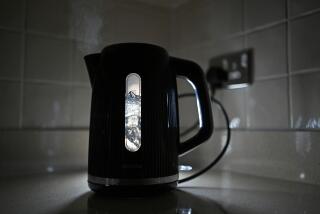Toledo’s tap water undrinkable for a second day; test results delayed
Water in Toledo, Ohio, and surrounding areas remained officially undrinkable Sunday evening, more than 36 hours after a do-not-drink order went into place for 500,000 people.
Water at a Toledo treatment plant tested positive for a toxin on Saturday, leading the governor to declare a state of emergency in three counties, state officials told the Los Angeles Times.
UPDATE: Toledo’s mayor lifts ban
At a Sunday morning news conference, Toledo Mayor D. Michael Collins said more results from new tests on the water would be available around noon. “This is not over yet,” he said.
But noon came and went with no test results. In the evening, the Toledo Blade and other local media reported that Collins had announced that the test results would not be available until 10 p.m. local time at the earliest. A few hours later, the test results were pushed back until “at least 1:15 a.m.,” a Blade reporter tweeted.
Ohio Gov. John Kasich declared a state of emergency for residents of Lucas, Wood and Fulton counties early Saturday after two water samples from a Toledo treatment plant tested positive for microcystin, a toxin possibly caused by an algae bloom in Lake Erie.
Carol Hester, a spokeswoman for the Ohio Environmental Protection Agency, told The Times on Sunday morning that water samples from the Collins Water Treatment Plant had been sent to three different labs and the state is still waiting for some of the results.
“We are awaiting results from all of those locations to be able to look at them all together as a whole and discuss with the technical experts what the results are and how to move forward,” she said.
Earlier Saturday, state officials warned residents in Toledo and surrounding areas not to drink, or even boil, the water tainted with microcystin, which can cause nausea and impair liver function. Though the chemical is rarely fatal to humans and more likely to kill animals and plant life, officials said residents of the affected counties should use the water only to bathe or wash their hands.
News of the contaminated water spread quickly throughout the city of 280,000, sending many residents flocking to Toledo shopping areas, neighboring cities and, in some cases, north to Michigan in search of fresh water.
Chris Abbruzzese, a state spokesman, told The Times that the Ohio Department of Transportation and National Guard were working to deliver water to Toledo. The state department of corrections also has access to a milk processing plant in Columbus, about two hours south of Toledo, and the agency was using it to produce water for city residents, he said.
Bottled water was being brought to the city early Saturday, Collins said.
The state also asked major grocery chains to divert as much water as they could to northwest Ohio, according to the Associated Press.
As truckloads of water came in from across the state, Toledo leaders set up distribution centers at schools around the city, limiting families to one case of bottled water each, AP reported.
Sam Melden, a native of West Toledo, told The Times he rushed to the nearest supply store around 9 a.m., only to find the shelves virtually barren.
“Costco was like a war zone, and they were limiting to like five cases,” he said.
Melden, who lives with his wife and two young daughters, and many of his neighbors were facing daunting trips out of town once they realized that local supplies were running short. But a neighbor woke up early, drove 30 miles north into Michigan, and brought back several cases of water for the neighborhood.
“I offered to pay and he said don’t worry about it,” Melden said.
In neighboring towns, which have access to water supplies not connected to the Collins plant, firefighters, churches and other officials have also been filling water containers and offering it to Toledo residents for free, Melden said.
The water shortage brought out the opportunistic side of some Toledo residents as well. Branden Cobb, a 25-year-old studying for his master’s in business at the University of Toledo, said he was on his way to buy water when he found a group of people selling cases for $12 each on the side of the road.
Cases were selling for only $3 each at the supermarket.
“It really is supply and demand,” Cobb told The Times. “I wish people wouldn’t up charge, up price, that. They had a good idea, but I personally wouldn’t do it.”
While the shortage has certainly made his Saturday more stressful, Cobb said Toledo residents aren’t panicking as long as they can find something safe to drink.
“As long as you have bottles of water, life hasn’t changed,” he said.
Abbruzzese told The Times that algae blooms in Lake Erie prompted the most recent tests.
While water service has not been shut off in the city, Abbruzzese warned residents to use the water as little as possible. He advised residents not have their children bathe, as they may accidentally ingest the water.
He could not immediately offer a timeline for when the water supply would be safe to drink.
Symptoms of microcystin ingestion can include diarrhea, nausea, dizziness and abnormal liver function, according to the alert.
In severe cases, seizures and respiratory arrest may occur, according to a 2012 report from the Environmental Protection Agency, but fatalities are rare.
As of 1 p.m., there had been no reported sickness, Collins, the mayor, said on Twitter.
Ohio EPA spokeswoman Heidi Griesmer said most of the algae bloom was in the western basin of Lake Erie, close to Toledo and the Ohio-Michigan border, adding that it was unlikely that the toxin would spread to other public water supplies.
“We have notified all of the public water systems in the area and asked them to increase sampling, they are all following our sampling protocol and they have not noticed any microcystin in their finished water,” she said.
While the toxin can be harmful to animals, Griesmer also said the contaminant would not make any fish caught in the lake poisonous to humans.
But other cities were taking precautions. Chicago officials announced Saturday that they would re-test the Lake Michigan water supply in the wake of the news out of Toledo, according to a report in the Chicago Tribune.
Recent tests, conducted almost biweekly, have not shown an increase of microcystin in the waters, the reports said.
Algae blooms occur when bodies of water receive excess phosphorous and nitrogen, which can be produced by fertilizer runoff or broken septic systems, Toledo officials said.
In the alert, Toledo officials said Lake Erie, which is a water source for Toledo and the larger Lucas County area, may have experienced such a bloom recently. Microcystin is one of several toxins that can be produced by an algae bloom.
While the toxins are harmful to humans, they are more likely to kill animals, according to the EPA report.
In 1996, more than 50 people died after they were exposed to microcystin at a dialysis center in Brazil, but the report did not detail any fatalities in the U.S.
Saturday’s incident marks only the second time Ohio has been forced to issue a “do not drink” warning because of algae-related toxins, according to Abbruzzese. A similar warning was issued in Carrol Township in 2013 after microcystin was detected there.
Still, the appearance of microcystin in Lake Erie is the third instance this year in which contaminated water has left large populations staring cautiously at their faucets. In January, a chemical spill outside Charleston left 300,000 West Virginia residents unable to drink their tap water.
One month later, a shattered pipe sent millions of gallons of coal sludge into a river that supplies drinking water to parts of North Carolina and Virginia, causing the levels of arsenic and other harmful chemicals in the water to spike.
Times staff writers Julie Westfall, Lauren Raab and Maya Srikrishnan contributed to this report.
Follow @JamesQueallyLAT for breaking news
More to Read
Sign up for Essential California
The most important California stories and recommendations in your inbox every morning.
You may occasionally receive promotional content from the Los Angeles Times.











